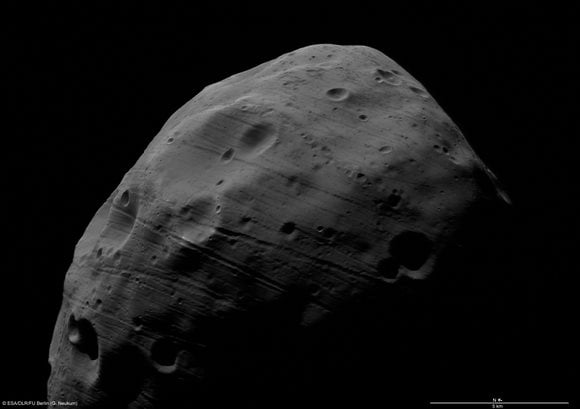[/caption] On July 23, Europe's Mars Express spacecraft flew only 93 kilometers from Mars' moon Phobos, and took the most detailed images ever of the small, irregular moon. Additionally, the spacecraft made other close flybys during the past few weeks, and creating a variety of images. The moon's grooved surface can be seen in the pictures quite clearly, but the origin of the grooves is not known. They could have been formed by ejecta thrown up from impacts on Mars, or if they could be caused by internal fissures result from the surface regolith, or soil, slipping into internal fissures. Whatever the cause, enjoy these new hi-resolution images of Phobos.
[caption id="attachment_16181" align="alignnone" width="400" caption="Phobos flyby. Credits: ESA/ DLR/ FU Berlin (G. Neukum)"]
[/caption] The best images taken by Mars Express have a resolution of 3.7 m/pixel and are taken in five channels different channels to create 3-D images, and to analyze the physical properties of the surface. Measuring 27 km × 22 km × 19 km, Phobos is one of the least reflective objects in the Solar System, thought to be a capture-asteroid or a remnant of the material that formed the planets.
A Russian sample return mission called Phobos-Grunt (Phobos soil), is scheduled to launch in 2009. It is expected to land on the far-side of Phobos at a region between 5° south to 5° north, and 230° west to 235° west. This region was last imaged in the 1970s by the Viking orbiters. The inset here shows potential landing sites for the Russian mission. [caption id="attachment_16182" align="alignnone" width="400" caption="Phobos. Credits: ESA/ DLR/ FU Berlin (G. Neukum)"]
[/caption]
The images obtained by several other spacecraft so far have either been of a lower resolution, or not available in 3D and have not covered the entire disc of Phobos. This is also the first time that portions of the far-side of the moon have been imaged in such high resolution (Phobos always faces Mars on the same side). Mars Express' High Resolution Camera (HRSC) Super-resolution channel (SRC) image taken on 22 July 2008 from a distance of 4500 km, showing the illuminated edge of the potential landing site of the Russian Phobos-Grunt mission. [caption id="attachment_16183" align="alignnone" width="400" caption="Phobos in 3-D. Credits: ESA/ DLR/ FU Berlin (G. Neukum)"]
[/caption] The imaging team is still working on producing additional images of the moon, including more in 3-D like this one. Managing the close fly-bys was an operational challenge, made possible by spacecraft operations engineers and scientists who worked together to specially optimise Mars Express’s trajectory and obtain the best possible views.
Original News Source:
ESA
 Universe Today
Universe Today
